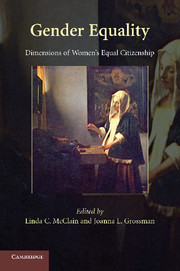Book contents
- Frontmatter
- Contents
- Contributors
- Acknowledgments
- Gender Equality
- Introduction
- PART I CONSTITUTIONAL CITIZENSHIP AND GENDER
- PART II POLITICAL CITIZENSHIP AND GENDER
- PART III SOCIAL CITIZENSHIP AND GENDER
- PART IV SEXUAL AND REPRODUCTIVE CITIZENSHIP
- PART V GLOBAL CITIZENSHIP AND GENDER
- 17 Women's Unequal Citizenship at the Border: Lessons From Three Nonfiction Films About the Women of Juárez
- 18 Domestic Violence, Citizenship, and Equality
- 19 On the Path to Equal Citizenship and Gender Equality: Political, Judicial, and Legal Empowerment of Muslim Women
- 20 Gender and Human Rights: Between Morals and Politics
- Suggested Readings
- Index
- References
17 - Women's Unequal Citizenship at the Border: Lessons From Three Nonfiction Films About the Women of Juárez
Published online by Cambridge University Press: 05 August 2012
- Frontmatter
- Contents
- Contributors
- Acknowledgments
- Gender Equality
- Introduction
- PART I CONSTITUTIONAL CITIZENSHIP AND GENDER
- PART II POLITICAL CITIZENSHIP AND GENDER
- PART III SOCIAL CITIZENSHIP AND GENDER
- PART IV SEXUAL AND REPRODUCTIVE CITIZENSHIP
- PART V GLOBAL CITIZENSHIP AND GENDER
- 17 Women's Unequal Citizenship at the Border: Lessons From Three Nonfiction Films About the Women of Juárez
- 18 Domestic Violence, Citizenship, and Equality
- 19 On the Path to Equal Citizenship and Gender Equality: Political, Judicial, and Legal Empowerment of Muslim Women
- 20 Gender and Human Rights: Between Morals and Politics
- Suggested Readings
- Index
- References
Summary
Illusive Borders, Illusive Citizenship
It is widely assumed that the citizenship of American women is only tested at the territorial borders of the country, and then only occasionally, when they attempt to return from abroad. As travelers with American passports, American women are allowed to enter many other countries without visas. Moreover, a majority find it as easy to reenter the United States as to leave it. For a minority, however, getting back into the country has proven difficult. Consider the African American women who, because of their race and gender, were stopped and intrusively patted down or strip-searched at airports upon their return from the Caribbean. Something as silly as a hat purchased on an island vacation could trigger scrutiny. Because these women were profiled as possible drug couriers, their U.S. citizenship provided them no security from intrusive surveillance as they stood at the gates of their country.
In fact, the vulnerability of American women to having their citizenship challenged when on U.S. soil changes along with the operative nature of the border. While borders are thought of as fixed, formally recognized, well-settled boundaries that are drawn on maps, demarcated by barbed wire fences and patrolled by soldiers or government agents, current events indicate that the borders are actually more indeterminate and illusive. Contemporary American immigration regulation has both shifted U.S. borders well into the nation's interior and extended them way beyond the nation's territory.
- Type
- Chapter
- Information
- Gender EqualityDimensions of Women's Equal Citizenship, pp. 359 - 377Publisher: Cambridge University PressPrint publication year: 2009

